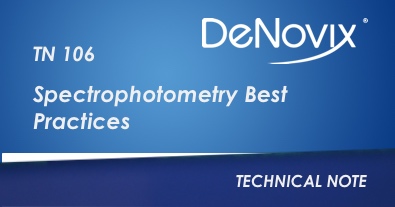Introduction
Microvolume spectrophotometric measurements are now routine in many life science research labs. As with all microvolume techniques, it is important to apply the best practices to reduce user error and ensure reliable results from a DeNovix DS-Series instrument.
Sample Surface Cleaning
- Use dH2O, not detergents or alcohol, for routine sample measurement surface cleaning.
Sample Delivery
- Clean both sample measurement surfaces prior to making the Blank measurement.
- Use a fresh aliquot for each measurement.
- Use a fresh tip to deliver each sample aliquot.
- Use 1 μL samples for routine measurements. Select the Short Path mode for high concentration 0.5 μL samples.
- Avoid introducing bubbles when pipetting samples onto the measurement surfaces.
- Use a dry lab wipe to remove the sample from both the top and bottom surfaces immediately after each measurement.
- Ensure that sample concentrations fall within absorbance limits of the instrument for accurate results.
Sample Preparation
- Ensure that sample isolation protocols are optimized and that samples are purified prior to measurement.
- Ensure that sample solutions are homogenous and well mixed before sampling.
Buffer Compatibility
- Use the same buffer that a sample is suspended in for the Blank measurements.
- Avoid buffers that contain components with strong absorbances at the wavelength of interest. Check the absorbance of the buffer by measuring it against a dH2O blank.
- Use colorimetric methods, such as the Pierce 660 nm Assay, for proteins suspended in RIPA buffers. Contact the reagent manufacturer for buffer compatibility.
- Take care when using volatile solvents. These solvents evaporate quickly, which can rapidly change the concentration of the sample aliquot.
Cuvette Compatibility
(DS-11 FX+, DS-11+, DS-8X+, DS-7+, DS-C)
- Use the correct cuvette size. The cuvette holder is designed to fit cuvettes with dimensions 12.5 mm W x 12.5 mm L x 45 mm H. Smaller pathlength cuvettes may be used with an adapter.
- Use clean cuvettes for each sample measurement. Clean the cuvettes according to the manufacturer’s recommended protocol.
- Use UV transparent quartz cuvettes for nucleic acid and Protein A280 measurements.
- Ensure that the cuvette is inserted in the proper orientation. The etched arrow on the instrument indicates the direction of the light path.
10-APR-2025



